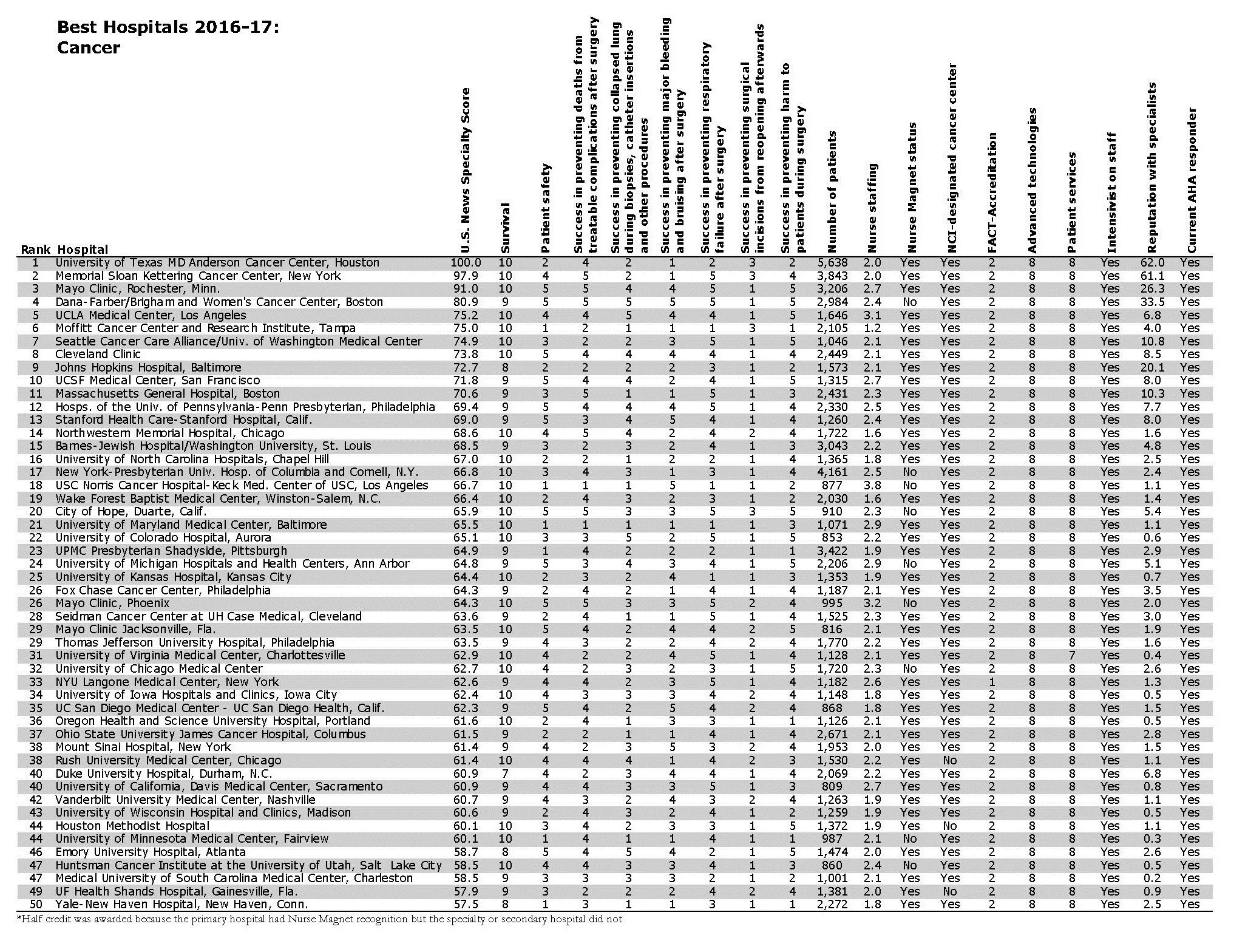The U.S. News & World Report rankings of the best cancer hospitals for 2016 brought no great surprises. The top four remained unchanged from last year:
- MD Anderson Cancer Center
- Memorial Sloan Kettering Cancer Center
- Mayo Clinic, Rochester, Minn.
- Dana-Farber/Brigham and Women’s Cancer Center
There was a change in the No. 5 slot: UCLA Medical Center. Last year, the Seattle Cancer Alliance and University of Washington Medical Center held that position. MD Anderson placed first nine times in the past 10 years.
“It’s an honor to once again be recognized as the nation’s top hospital for cancer care, which we have earned through our unrelenting passion to serve patients and fulfill our mission to end cancer,” said MD Anderson President Ronald DePinho.
U.S. News uses four metrics to evaluate scores for cancer centers: “outcomes” account for 37.5 percent of the score; “structure” accounts for 30 percent; and “process” or “reputation” accounts for 27.5 percent; and “patient safety” accounts for 5 percent of the score.
It’s unclear whether the metrics and multiple statistical adjustments U.S. News uses accurately reflect the quality of the cancer centers, particularly since one key metric—the reputation score—consistently favors MD Anderson and Memorial Sloan Kettering.
“Everyone recognizes [the ranking’s] shortcomings, but all want to be on the list, because the public reads it, and can make judgments based on it. Reputation ratings obviously favor the bigger centers that have deeper staff and better name recognition, but the report often misses the big issues, like which organization is doing the most innovative work in what cancers,” said Vincent Devita, former NCI director and former director of Yale Cancer Center. He is now the Amy and Joseph Perella professor of medical oncology and professor of epidemiology at Yale Medical School.
MD Anderson and MSKCC once again received the highest reputation scores, followed by a steep drop-off: MD Anderson had a reputation score of 62, with MSKCC at 61.1—then Mayo in third, scoring 33.5; Dana Farber/Brigham and Women’s at 26.3; and UCLA at 6.8.
To calculate reputation scores for each institution, U.S. News posed the following question to board-certified oncologists through the post and physician social networking site Doximity: “Please name up to five U.S. hospitals that you believe provide the best care in oncology for patients who have the most challenging conditions or who need particularly difficult procedures. Do not consider location or cost.”
The reputation score was determined by a survey of two separate cohorts:
- The Doximity Masterfile member survey, which was conducted with 9,672 cancer specialists; 9.6 percent of whom responded.
- The mail survey, which was sent to 200 oncologists who are not Doximity members; 28.4 percent of whom responded.
The results were stratified by census region, weighted, put through log transformation and averaged over three years.
The Cancer Letter asked Søren Bentzen, division director of the University of Maryland School of Medicine’s department of Biostatistics and Bioinformatics, to assess the contribution of the reputation score—and its real-world validity. His analysis appears here.
MD Anderson scored a 2/5 in patient safety, but only four of the top 10 institutions scored a 5/5 on patient safety.
Many hospitals with low rankings, or no ranking at all, are nonetheless regarded as excellent by patients and doctors. For example, Yale-New Haven Hospital, an NCI-designated comprehensive cancer center, was ranked 50, after receiving an overall score of 57.5 out of 100. UT Southwestern Medical Center, like many other cancer centers, including other NCI-designated cancer centers, did not receive a ranking and is simply listed as a high-performing cancer center.
Directors of cancer centers, those in marketing, and patients pay close attention to changes in the standing of their institutions.
“This ranking reflects the extraordinary care delivered by our teams of highly subspecialized physicians, outstanding oncology nurses and dedicated supportive care professionals, all working together for the benefit of each patient who comes through our doors,” said Thomas Buchholz, executive vice president and physician-in-chief at MD Anderson. “These professionals, many recognized internationally as leaders in their fields, have a great dedication, passion and expertise for their work and the patients they serve.”
Other top ranking cancer centers released similar statements:
“U.S. News and World Report consistently recognizes us as a top hospital for cancer care. We’re proud of the ‘best hospital’ distinction, but we’re even more proud of our compassionate and dedicated staff,” Memorial Sloan Kettering said in a statement.
“At Mayo Clinic, nothing is more important than insuring that all our patients receive the highest quality of care each time they turn to us. We’re honored that Mayo is highly ranked by more well-known national assessment organizations than any other hospital or clinic in the nation,” said John Noseworthy, president and CEO of Mayo Clinic. “While no single set of measures can perfectly represent health care quality, we’re grateful to be recognized by so many.”
In a press release, Dana-Farber/Brigham and Women’s Cancer Center said patients rely on the rankings in making health care decisions: “The U.S. News Best Hospitals 2016-17 rankings, now in their 27th year, help guide patients to hospitals that deliver outstanding care across 25 specialties, procedures and conditions.”
“We are proud of our talented and compassionate caregivers, whose hard work is recognized by this honor. We strive to provide the very best cancer care possible, and to develop new and more effective therapies to help patients and their families beat this devastating disease,” Edward Benz, president and CEO of Dana-Farber, said in the statement.
U.S. News releases tables that show many NCI-designated cancer centers that end up with barely detectable “reputation with specialists” scores.
The 2016 table appears below:
This can be compared with last year’s table:















